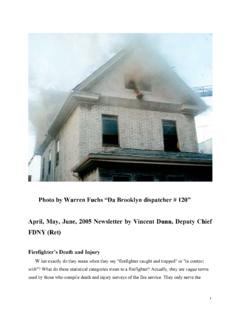Transcription of United States Fire Administration - Emergency …
1 Improving FirefighterCommunicationsSPECIAL REPORTU nited States fire AdministrationFederal Emergency Management AgencyUnited States fire AdministrationTechnical Report SeriesUnited States fire AdministrationMajor fire Investigation ProgramThe United States fire Administration develops reports on selected major fires throughout thecountry. The fires usually involve multiple deaths or a large loss of property. But the primary criterionfor deciding to write a report is whether it will result in significant lessons learned. In some cases theselessons bring to light new knowledge about fire -- the effect of building construction or contents, humanbehavior in fire , etc. In other cases, the lessons are not new, but are serious enough to highlight onceagain because of another fire tragedy. In some cases, special reports are developed to discuss events,drills, or new technologies or tactics that are of interest to the fire service.
2 The reports are sent to fire magazines and are distributed at national and regional fire reports are available on request from USFA. Announcements of their availability are published widelyin fire journals and body of work provides detailed information on the nature of the fire problem forpolicymakers who must decide on allocations of resources between fire and other pressing problems, andwithin the fire service to improve codes and code enforcement, training, public fire education, buildingtechnology, and other related fire Administration , which has no regulatory authority, sends an experienced fireinvestigator into a community after a major incident only after having conferred with the local fireauthorities to insure that USFA's assistance and presence would be supportive and would in no wayinterfere with any review of the incident they are themselves conducting.
3 The intent is not to arriveduring the event or even immediately after, but rather after the dust settles, so that a complete andobjective review of all the important aspects of the incident can be made. Local authorities review USFA'sreport while it is in draft form. The USFA investigator or team is available to local authorities shouldthey wish to request technical assistance for their own additional copies of this report write to the United States fire Administration , 16825 SouthSeton Avenue, Emmitsburg, Maryland 21727 or via USFA WEB Page at Firefighter CommunicationsSPECIAL REPORTR eporting by: Adam ThielEdited by: Hollis StambaughThis is Report 099 of the Major Fires Investigation Project conducted by Varley-Campbell and Associates, Corporation under contract EMW-94-C-4423 to theUnited States fire Administration , Federal Emergency Management Agency, and is availablefrom USFA WEB Page at States fire AdministrationFederal Emergency Management AgencyTABLE OF OF COMMUNICATION System of the Loop.
4 Two-Way OF 1 ACKNOWLEDGEMENTSThe United States fire Administration greatly appreciates the cooperation receivedfrom the following people and organizations during the preparation of this report:City of New York (NY) fire DepartmentCommissioner Thomas Von EssenAssistant Chief Peter GanciAssistant Chief Frank CruthersDeputy Chief James MurtaghDeputy Chief Stephen KingDeputy Chief Richard FanningBattalion Chief Edward GeraghtyBattalion Chief Richard ComiskeyBattalion Chief Frank MialeBattalion Chief George GiererLt. Steve Spahl Special Operations CommandMembers of Engine Companies 48 and 75 Members of Ladder Companies 37 and 33 Members of Rescue Company 1 Memphis Division of FireDirector Charles SmithOther References TriData Corporation, Wildland Firefighter Safety Awareness Study Phase III Implementing Cultural Changes for Safety, March 1998 Varone, J. Curtis, Fireground Radio Communication and Firefighter Safety, NationalFire Academy Executive fire Officer Program, 1996 Outstanding Research Award Kaprow, Miriam Lee, Magical Work: Firefighters in New York, Human Organization(Society for Applied Anthropology, , , Spring 1991) Federal Aviation Administration , Developing Advanced Crew Resource ManagementTraining: A Training Manual, August, 1998 Comfort, Louise K.
5 , ed., Managing Disaster: Strategies and Policy Perspectives,(Durham: Duke University Press, 1988)Page 2 EXECUTIVE SUMMARYS everal recent incidents involving firefighter fatalities demonstrate that, despitetechnological advances in two-way radio communications, important information is notalways adequately communicated on the fireground or Emergency incident communication has a definite negative impact on the safety of emergencypersonnel and may contribute to injuries or deaths of firefighters, rescue workers, fireground communication is repeatedly cited as a contributing factor inmany of the incidents reported through the United States fire Administration Major FiresInvestigation Project. This fact, coupled with the limited availability of research on suchan important topic, prompted the United States fire Administration (USFA) to studysome of the potential causes of communication breakdown, and to providerecommendations that will help departments improve their operational the findings contained in this special report are primarily oriented toward themunicipal fire service, this does not diminish their potential relevance to other firefightersand Emergency responders.
6 With respect to communicating in high-stress environments,numerous parallels exist across public safety and related disciplines. Some of the ideaspresented here are drawn from the experiences of wildland firefighters, airline flight crews,and military 3 KEY ISSUESI ssuesCommentsUnsuitableequipmentThe chief communication problem reported by firefighters and company officers isthe difficulty with communicating from inside a fire when using full personalprotective equipment, including SCBA. The majority of portable radios currentlyused by fire departments are ill-suited for the radiosneeded for allfirefightersDespite some technical limitations, portable radios are a proven lifesaver during firesand Emergency incidents, they should be considered a critical item of personalprotective equipment akin to SCBA. Ideally, every firefighter working in a hostileenvironment should have a portable radio with Emergency distress attentionpaid to humanfactorsThere is a dearth of available literature pertaining to the impact of human factors oneffective fireground communication.
7 Furthermore, while fire departments devotesubstantial time to manipulative skill training, relatively little training is provided tohelp firefighters develop stress-tempered communication ofactive listeningAll firefighters on an Emergency incident should actively monitor their radios forimportant information at all times, not just when specifically should be emphasized as an essential part of firefighter functional asa tactical team, not just operating as individual messageformats andlanguageFire departments can enhance fireground communication by creating standardmessage formats and keywords used consistently. Plain English is usually preferredover codes, especially when transmitting a complex messagepriorityKeywords to prompt immediate action can be tiered based on their priority, forexample, Mayday signals a life-or-death situation, while Urgent may be used tosignify a potentially, serious problem.
8 Such message headers prompt the crew slistening priorities and radio tocultural factorsIf necessary, firefighters are not usually reluctant to circumvent the chain ofcommand to report critical safety issues. There may be greater hesitation tocommunicate problems in completing an assigned task. However, this is usually dueto a lack of situational awareness, and not a fear of reprisal from other on firefighter communications show that sometimes the culture of bravery inthe fire service is reflected in a reluctance to communicate quickly enough when helpis needed. Repeated situations where this occurs should be closely examined by 4 INTRODUCTIONC ommunication problems are continually cited as contributing factors in fires andemergency incidents where firefighters are killed or injured. The number of near-miss incidents where fireground communication was ineffective may be higher than generallyrealized.
9 The purpose of this special report is to help fire departments improve theircommunication processes to enhance scene safety, help prevent firefighter deaths andinjuries, as well as to promote effective tactical the obvious importance of effective communication on the emergencyscene, only a limited amount of published research exists dealing specifically with thistopic. Several recent programs have focused on improving wildland firefighter safety. Arich source of literature on communicating in emergencies is available in the field of airlinecrew resource management. Efforts to improve operational communication andcoordination also exist in the military. This report will draw parallels betweencommunications-related issues in these areas and the municipal fire validate the applicability of the information presented in this report onfireground communication, field research was conducted with assistance from the City ofNew York fire Department (FDNY).
10 The FDNY was selected based on frequency of fireincidents, a strong interest in the topic, and a demonstrated willingness to cooperate withUSFA researchers. While certainly not the final word on fire service communication,this special report may help identify future avenues of inquiry and will provide somesuggestions that can be implemented by fire 5 INCIDENT SUMMARIESMany fire departments conduct formal internal reviews of their major incidents toenhance their training for better practices. However, the fire Administrationexamines major incidents to ascertain lessons learned that can be communicated to thenation s fire safety community. Summaries of communications-related lessons learned at avariety of incidents are summarized below to help identify commonalties and trends in theexperiences of fire Wood Truss Roof Collapse Claims Two Firefighters, Memphis, TN(USFA Technical Report Series) Two firefighters operating an interior attackline were killed at this fire after a church roof collapsed.






